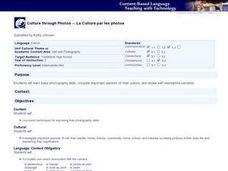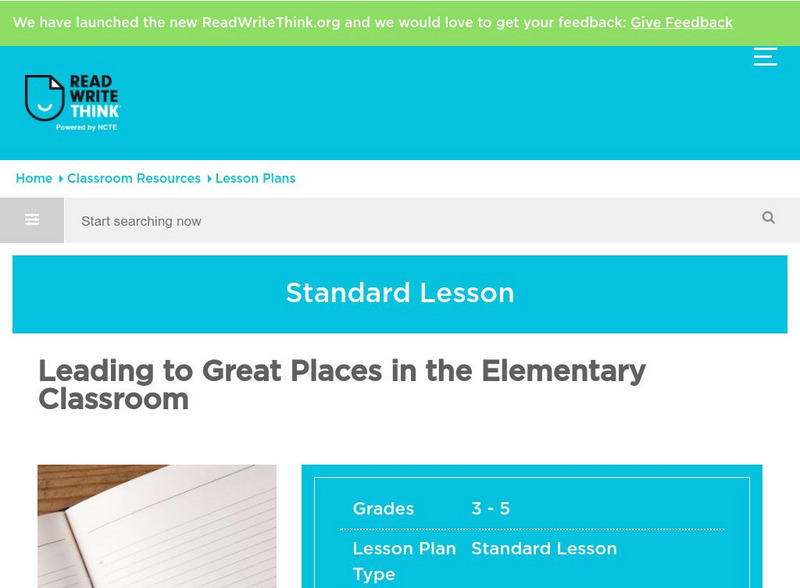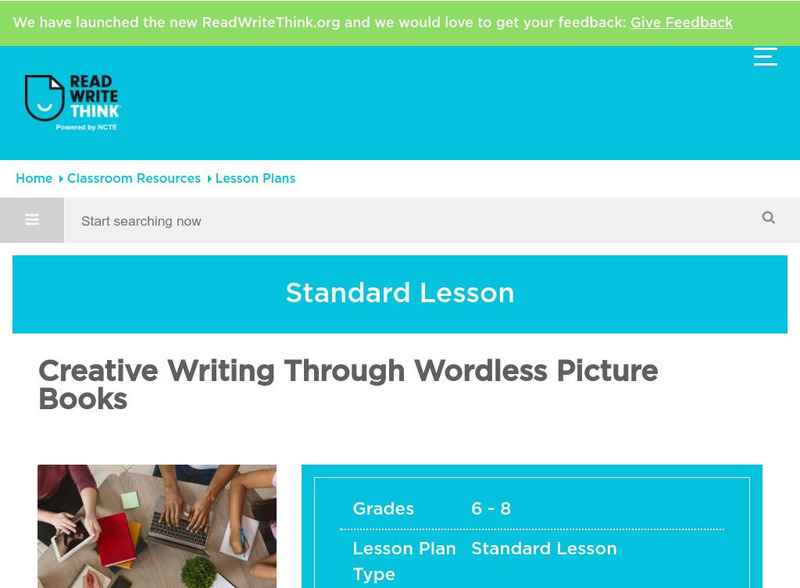Curated OER
Elements of Fiction
A wide variety of information regarding the elements of fiction is presented in this PowerPoint. Viewers are directed to trace their hand on a blank piece of paper and label each finger with one of the 5 elements of fiction. Additional...
National Endowment for the Humanities
Edgar Allan Poe, Ambrose Bierce, and the Unreliable Narrator
Stories by Edgar Allan Poe and Ambrose Bierce provide readers with an opportunity to investigate unreliable narrators. The lesson plan begins with an activity about different types of point of view and continues as scholars apply their...
Bermudian Springs School District
John Steinbeck The Grapes of Wrath — Independent Reading
Lies, deceit, betrayal, criminality: these topics are just a few of the reasons that John Steinbeck's classic novel The Grapes of Wrath has captivated people since its 1939 publication. Scholars begin the lesson by reading...
Curriculum Corner
"Would You Rather?" Writing Prompts
Would you rather eat a cricket or a worm? Have your young writers decide and write about why. Choose from 35 different writing prompts to spark interest and creativity. Even your most reluctant writers are sure to enjoy. Each prompt also...
Manchester College
What’s Your Point of View?
Work on deciphering the point of view of various pieces of literature. As readers review the concepts of first, second, and third person perspective, they apply what they know to different passages.
Curated OER
Storytelling
Show young readers how to put some personality and voice into their storytelling with an in-depth assignment. Kids practice saying the same thing, such as counting from one to ten, in different tones and perspectives, and then work on...
Curated OER
Hatchet: Concept Analysis
Take an in-depth look into Gary Paulsen's Hatchet with a concept guide. With a list and explanation of thematic motifs, types of conflicts, and vocabulary in the novel, learners will engage with the text in a whole new way.
Curated OER
Self and Photography
Eleventh graders, after investigating and studying self, family, friends, etc. by taking pictures of their daily life, assess basic photography skills that reflect aspects of their culture. They review those aspects and write a...
Curated OER
Characterizations: Indirect and Direct
Connect literature to narrative writing by researching descriptive writing techniques. Elementary and middle schoolers identify the importance of a narrator and voice in the storytelling process. They read writing samples and identify...
Curated OER
Hawthorne: Author and Narrator
Students examine the difference between a narrator and author. They read Nathaniel Hawthorne's novel, 'The Scarlet Letter,' write a description of the narrator, and research how Hawthorne was impacted by the politics of the time.
Curated OER
Faulkner's The Sound and the Fury: Narration, Voice, and the Compson Family's New System
Students complete a variety of discussion and writing activities surrounding the study of Faulkner's The Sound and the Fury.
Curated OER
15 Seconds of Fame
Students write an autobiographical essay. In this writing lesson plan students read a narrative, Panic in Paris, and review the elements of a narrative as a class discussion. Well-known stories are used as examples for writing their own...
National Endowment for the Humanities
Family Voices In As I Lay Dying
Learners analyze William Faulkner's 'As I Lay Dying' and his use of multiple voices. For this William Faulkner lesson plan, students analyze Faulkner's use of multiple voices in narration. Learners examine the Bundren family through the...
National Endowment for the Humanities
Faulkner's As I Lay Dying: Images of Faulkner and the South
Learners research one aspect of the life of Faulkner and the culture of the South. For this As I Lay Dying instructional activity, learners explore a webpage on Faulkner and write a summary. Learners analyze the images...
Curated OER
Reported Speech
In this reported speech learning exercise, students complete the second sentence given to represent reported speech. Students write 15 lines total on this learning exercise.
Curated OER
Writing Application: The Canterbury Tales
Students read stories from The Canterbury Tales by Geoffrey Chaucer and create their own tale. In this writing applications instructional activity, students read the tales and analyze the specific details that Chaucer use. Students work...
Curated OER
Listening and Speaking
Ninth graders practice the elements of narration. In this narration lesson, 9th graders complete learning profile activities to address kinesthetic learners, artistic learners, musical learners, and interpersonal learners. Students work...
Curated OER
Animaters and Lego Mania!
Students use various technology elements to storyboard and create an animal animation story based on a nonfiction story they've read. In this animation story lesson plan, students work in groups and read nonfiction animal stories....
ReadWriteThink
Read Write Think: Leading to Great Places in the Classroom
We all know that the most effective way to teach reading is to start with reading. This lesson uses that approach with writing story leads.
ReadWriteThink
Read Write Think: Creative Writing Through Wordless Picture Books
Need help planning ways to creatively teach your students chronological order? Here's a great place to start. While the site is specifically geared toward the middle school student, it is a teaching idea which could easily be adapted for...
ReadWriteThink
Read Write Think: Expository Escapade: Detective's Handbook
Working on higher-level thinking skills with your readers is made easier with this lesson. You will have your young scholars connect with and analyze a mystery story at their grade-appropriate level. Lesson plan, printable worksheets,...
ReadWriteThink
Read Write Think: Draw a Story: Stepping From Pictures to Writing
Help young students move from drawing pictures into writing simple stories. Good plan for having students put pictures in sequential order and teaching them about sequential order.
Texas Education Agency
Texas Gateway: Point of View and Tone (English Ii Reading)
[Accessible by TX Educators. Free Registration/Login Required] Evaluate connections between forms of narration (unreliable narrator, omniscient, etc.) and tone in works of fiction.
Teachers.net
Teachers.net: The Gingerbread Man
Introduce your primary learners to retelling and sequencing skills. Will also help move your students to higher-level thinking which deals with characters, setting, and plot. Site offers one week's worth of lessons.

























